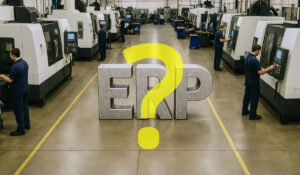IS INDUSTRY 4.0 A MARKETING BUBBLE?
One of the signs that something is just a “bait” in the IT world can be when the word or phrase is misused by trendsetters, influencers, even senior managers, sales people and consultants. Obviously, this has happened in Industry 4.0, IoT and Smart Factories. What about this? Let’s look at how to approach this topic a little more soberly.
The beginnings of the concept of Industry 4.0 can already be found after the high-tech strategy projects of the German government from 2011, which strongly started the support of automation in production. The concept of Industry 4.0 was introduced to the public in the same year at the Hannover Fair. Today, almost every IT or industrial automation company uses this term to describe their products or services, creating unnecessary confusion.
We are trying to say that companies do not sell Industry 4.0, but sell and implement specific products – robots, PLCs, MES/MOM solutions, WMS, CAD, etc. Our opinion is that the vast majority of companies use “big words” to impress their potential customers. And Industry 4.0 is one of these words. Ultimately, however, these firms sell and implement specific products with a defined range of activities. And often even products that cover only a few banal processes that are not so crucial for the operation of the company. This can create the illusion that the company uses the latest technology and is therefore among the advanced and efficient ones. That could be a mistake.
Are you a shift manager, a production manager or the owner of a manufacturing company? Ask yourself the following question: how long would it take you to find out exactly what every person and machine in your production is doing at this moment? Can you quantify this information immediately? And we’re talking real-time data, not data from yesterday or since the start of today’s shift.
In case you hesitate to answer, or would need significantly more than 3 minutes at your desk to get the right information, allow me one piece of advice: don’t worry about Industry 4.0, Smart Factories or IoT… You need something else.
We humans have a remarkable ability to visualize what we want to achieve at the end of a project, but we tend to forget what needs to be done to achieve that goal. In order to succeed, we need to structure the project and break it down into smaller tasks and individual steps. The same login applies to Industry 4.0.
From what we see with our ongoing and implemented MES/MOM projects in many European countries, we can say that, for example, the Danish Industry 4.0 is very different from the Romanian Industry 4.0. Why? Let me give some examples:
- readiness of local production processes;
- technology migration in a corporate enterprise environment (legacy IMMs travel from west to east);
- different technology requirements, people’s willingness to use the latest trends.
The idea is clear enough without further explanation. We can talk about Detailed Production Scheduling (APS), augmented reality (AR), additive manufacturing (AM), etc. However, if basic processes such as data collection from machines and operators or ERP integration are overlooked, then Industry 4.0 is just a bubble that distracts you from working on improving production processes in a reasonable order and with an emphasis on the currently necessary steps. We should not and cannot skip any step on the way to perfection for information and digital production support (which is the main goal of the initiative called Industry 4.0).
So the question is, how do you get there? How to achieve the dream and live the so-called Industry 4.0? You should probably start asking those Industry 4.0 vendors the right questions, like how ready are they and how robust are their solutions and services.
First, check the processes
Pay attention to the ISA-95 standard and get inspired! Don’t look for partial solutions. If you do this, you will likely need additional integration with other systems in the near future, which will only bring additional expenses. Look for a true MES/MOM system that addresses the processes you want to cover now and will need to cover in the future. Make it easy for yourself to start with – focus on the following areas in order. You can change points C, D, E according to the actual state of your processes.
- Management and Monitoring of production in real time (missing labor deductions at the end of each shift, delayed information about downtime, no record of deviations or coffee breaks…)
- Quality assurance (data collection and evaluation, reports, optimization, corrective measures…)
- Real-time production planning that reflects the actual status of machines, material stocks, staff availability, downtime, maintenance, breakdowns…
- Production logistics (unique identification of pieces, packaging units, traceability of pieces, KANBAN…)
- Maintenance (predictive maintenance, automated generation of maintenance requests in real-time, reports, integration to the real-time scheduler…)
Evaluate the flexibility of the integration
Is the product ready to communicate with third-party products? I mean API readiness, user reports, custom visualization screen editor, XAML (customizable production client graphical interface), etc.
Check the technologies in the connected peripherals
What is the available standard for data collection? OPC DA, Euromap 63, Euromap 77, OPC UA, VE 437, RS-xxx… Can the product be integrated with older machines or third-party software?
Does the product follow the latest trends?
Cloud solution or on-site installation, one-time payment vs. subscription, additive manufacturing (AM), augmented reality (AR)
Product development and support
Regular SW updates, compliance with standards such as IATF 16 949, FDA CFR Part 11, …
The integrator’s readiness for implementations outside its main region
Can your integrator ensure system implementation in your factories abroad? Are foreign implementation partners available? Direct or indirect implementation? How many language localizations the system supports.
We are sure that no one wants to buy any IT solution because you like a specific functionality. You need to look for a reliable solution and a service that dynamically adapts to your needs and your customers. Don’t look for shortcuts or tricks and forget about all ready-made, so-called “boxed” software products.
MES/MOM is not something you set and forget. It is something that grows and lives with you and your production every day, together with your employees and the demands of your customers.
In the automotive industry, these “unheard of” requirements (mentioned above) can lead to the end of your competition. Don’t be like them, listen to the requirements of the automotive sector and make YOUR satisfied customers in it.
Jiří Jakubec, Business Developer MES PHARIS



